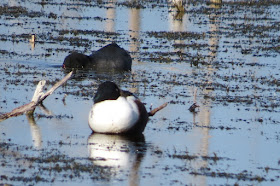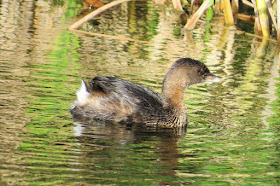Wednesday January 15th
There is a Flamingo, to be seen at St Marks National Wildlife Refuge. This single bird must not mind being the sole representative for its species in North Florida. Its been here off and on for over a year now. Usually flamingos are found further south and not that often even in south Florida.
 |
| Pied-billed Grebe |
I had arrived this morning about 7 am. Its still dark and very foggy and I'm not the first on site. As dawn breaks a small crowd has gathered at the East River Pool over look waiting for the fog to clear. Unfortunately it would clear up till around 10 o'clock. We had some nice birding the location as we waited. The beautiful male Vermilion Flycatcher was active in the area. We also had King and Virginia Rails, Wilson's Snipes, Greater Yellowlegs, Savannah and Song Sparrows, Orange-crowned and Yellow-rumped Warblers.
 |
| Its a bit foggy for the Vermilion Flycatcher |
 |
| Barred Owl |
Relocated to the Lighthouse around 9 am. The fog seemed to be getting thicker. Checked out the ponds and lakes. Had a single Glossy Ibis, which had to be checked for red eyes. Which it didn't have. The waterfowl appeared to be diminishing in variety and counts. Still we have birds. American Widgeons, Gadwalls, Hooded Mergansers, Red-breasted Mergansers, Lesser Scaup, canvasbacks, Redhead, Buffleheads, Common Goldeneye, Pied-billed Grebes, Anhingas Common Loon. Brown pelicans, Cormorants, Ruddy Turnstones, Willets, Ring-billed Gulls, Forster's Terns too.
Got the word that that the Flamingo could now be spotted after the fog had lifted. Quickly returned to East River Pool. It was pretty far off. Too far away for my camera but that red plumage really sticks out.
 |
| Song Sparrow |
Next up was a search for a henslows sparrow at the helapad location. I joined with Charlie Bostwick and his wife for a sparrow walk. We had Marsh and Sedge Wrens and a Lincoln's Sparrow. I didn't get the henslow, but Charlie heard it. The pine forest here also yielded Eastern Towhee, Brown-headed Nuthatch, Pine Warbler, Great Horned Owl and-bellied Woodpeckers
Didn't see everthing on my list. But not a bad day
 |
| Fiddler Crab |
 |
| Green Anole |
 |
| Queen Butterfly feeding on Tropical Milkweed |
 |
| Basking Gator |
 |
| Atamasco Lily |
 |
| Glossy Ibis |






















































